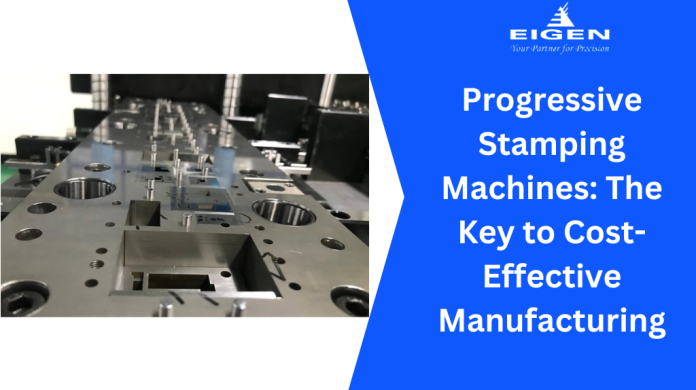Traditional metal stamping methods rely on motor powered presses that typically perform a single, particular operation or stroke. This method cannot conduct numerous operations simultaneously.
As a result, limitations include the difficulty of producing complex parts and the high total manufacturing cost. Here comes the progressive stamping machine that addresses these obstacles by streamlining the manufacturing process.
It allows for the creation of complicated parts with more efficiency and cost effectiveness. In this post, you can look into the cost-effective benefits of progressive metal stamping.
What Is Progressive Die Stamping?
Progressive die stamping is commonly known as prog die stamping. It is a versatile method enabling efficient and affordable production of a wide range of parts and products.
During this die stamping process, a stock strip transports the component through a chain of independent work stations, each performing a unique operation at the workpiece, which include bending, punching, or coining.
As the component travels through every station, it step by step acquires the desired size and shape. Once finished, the element goes off the stock strip to reveal the finished product.
The Key to Cost Effective Manufacturing
- Less Scrap Material
Progressive stamping is a metalworking procedure that includes punching, coining, bending, and other methods. This system involved progressive steel stamping to acquire the preferred element shape. The big majority of the material is used on this system.
This affects minimum scrap. Progressive Die Metal Stamping can be the most affordable material option for producing your parts.
- Speed and Efficiency
One of the advantages of a progressive stamping machine is its ability to generate stamping parts at an astoundingly fast rate. With the continuous feed procedure, several parts are shaped in the course of every press cycle.
This approach that, once installation, a stamping system can produce heaps of components each hour, relying on the intricacy of the design. In a short period, you may produce many portions and thus save more cost.
- Reduced Labor Costs
In organizations where even a millimeter of inaccuracy can result in product failure, precision progressive stamping is a lifesaver. The custom designed dies make certain that each element produced is equal to the last while adhering strictly to design requirements.
This consistency is crucial, specifically when creating components for aerospace or medical system industries.
Physical manpower isn’t required to supervise the manner due to the digital tracking generation that has been evolved. As a result, the tools can be left unattended, saving manufacturers the cost of an additional group of workers.
- Decreased Machine Setup Time
Short run die stamping and other metallic forming techniques necessitate multiple setups to make the desired components. However, progressive stamping distinguishes itself by requiring only a single tool.
This singular tool usage contributes to each less expensive and operational performance. It streamlines the manufacturing system and decreases the complexities associated with tool changes in other methods.
- Better tooling cost
In the progressive stamping system, the initial tooling fees are sometimes higher. This is because of the sophisticated shape of a single progressive die.
However, the benefit is the viable reduction in tooling expenses over time, that is helped with the aid of integrating better production volumes.
Applications of progressive die stamping
- Automotive industry
In the automotive industry, a main manufacturer used progressive die stamping to provide a key component in large quantities. The result became a widespread reduction in dimensional versions, which improved overall standard quality and reduced the rejection charge.
- Electronics Industry
An electronics corporation used progressive die stamping to manufacture connection parts. The consistency acquired across tens of millions of elements resulted in a large discount in faults, growing the reliability of connectors.
- Aerospace Domain
In the aerospace enterprise, a manufacturer switched to progressive die stamping to produce the best precision brackets. Over long manufacturing runs, the changeover ensured the worrying aerospace satisfactory criteria were constantly met.
- Medical sector
Progressive die stamping has become popular within the medical industry for making surgical devices, dental devices, and implantable components. The method’s capability to maintain tight tolerances and excessive standards is important in this sector.
Final thoughts
Progressive stamping is an effective choice for excessive production desires, offering greater benefits in cost. As businesses attempt for greater efficiency and sustainability, Progressive Die Stamping will play a more and more vital role in determining the future contours of manufacturing excellence.


